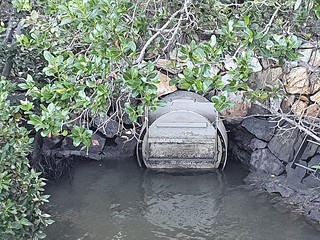The Government Gardens were surveyed and selected as the site for a Public Garden in 1828 by the New South Wales Colonial Botanist, Charles Fraser. It is main function at that time was to find out which plants could be best cultivate on this land and in this climate. Based on the results of the experiments the production of food for the new settlement was based. The 22 acre site was situated to the southwest of the settlement on the site of the present-day City Botanic Gardens on Alice Street. It also bordered the Commander’s Garden along William Street, were food for the senior staff was produced.
Approximately in the middle of the garden stood the cottage of the gardener. It was replaced in the 1850s with the current building, now the Gardens Club Cafe.
When Fraser re-visited Brisbane Town a year later he was very happy with what Mr. Hopson the gardener had achieved. Fraser wrote that the garden covered approximately fifteen acres of land, had a six rail fence, the walks had been finished, and most of the garden was used for crops.
The Government Garden was under the command of the Superintendent of Agriculture. There was a permanent workforce of between 30 and 35 convicts employed here. Apart from the maize fields for the staple foods there were a wide range of vegetables including cabbage, cauliflower, peas, beans, potatoes, and pumpkins, as well as fruit trees and plants such as banana, pineapple, citrus, and apple. There was a small hut where convicts would strip the maize kernels from the cobs before carrying the sacks to the windmill. There was a small piggery next to the corn shed. The convicts had also created a reservoir, most likely in the Little Creek the flowed through the are. Once the number of convicts started to drop also the food production and the maintenance of the garden became neglected.
Because of its proximity to the Female Prison, some 40 women were also deployed here, strictly separated from both the male prisoners and the soldiers. The bridge of the Wheat Creek was the demarcation line, beyond that soldiers were not allowed. Nevertheless sexual encounters were regularly reported.
In 1829, Principal Medical Officer James Bowman and inspector of colonial hospitals in NSW reported that there finally was every day an abundant supply of vegetables. He mentioned that this would be helpful in eradicating scurvy that had been prevalent in the colony in previous years.
In 1851 an application was send to the Governor to cut off of piece of land from the sale of the Government’s Garden so that it might become the site for a government house.
And indeed the next building to be built in the Gardens was Government’s House.While there was a significant lack of funds when Queensland became independent in 1859, the first Queensland Parliament rapidly agreed plans to build a residential building to accommodate the first Governor of Queensland, Sir George Bowen, and his family. Now more than 150 years later it arguable still is Brisbane’s most attractive building.
The site chosen for the building was a high point of Gardens Point overlooking the Brisbane Botanic Gardens and with expansive vistas of the Brisbane River. The two-storey building was designed by colonial architect Charles Tiffin in the Classical revival style in 1860. The front half of the building contained the Governor’s public and private rooms while the rear housed the service section. The first stage of the building was completed in March 1862.
Other early building work in the area included a Superintendent’s cottage in the late 1850s, a platform for a battery of cannon in the early 1860s, a stone and iron fence around Queen’s Park (situated along Alice Street) in 1865-66 and a drinking fountain in 1867. The fountain was designed by Colonial Architect, Charles Tiffin and later became known as the Walter Hill fountain. Hill was the first superintendent of the Botanical Gardens. He was also responsible for the planting of the magnificent fig trees at Eagle Place.
The above mentioned Gardener’s house, octagonal in shape and consisting of three rooms surrounded by verandahs, is currently in use as a restaurant.
The route of the roadway along the western end of the settlement from the Prisoners’ Barracks to the Government Gardens overlaps with the current Albert Street on the block between Margaret and Alice Streets. There were a few planks that served as a bridge over a small creak that runs into the Brisbane River at the end of Alice Street.

The Gardens were also the home for over 100 years for Harriet, a tortoise reportedly collected by Charles Darwin during his visit to the Galápagos Islands in 1835 and donated to the Gardens in 1860 by John Clements Wickham, former commander of HMS Beagle and later Pro-Government Resident for Moreton Bay. Harriet was in her later life named in honour of Harry Oakman, curator of the Gardens from 1945 to 1962 and the creator of the (now disbanded) zoo at the Gardens. The zoo closed in 1952. Harriet lived out her final years at Australia Zoo until dying in June 2006.
Harry Oakman also developed for plans of the parklands along Wickham Terrace and the current Roma Street Parklands contain many elements of his designs. He is honoured here with a pavilion named after him.
When Brisbane was opened for new settlers, the Gardens became grazing ground for cows. In 1855 a portion of several acres was declared a Botanic Reserve which were later were turned into the City Botanical Gardens